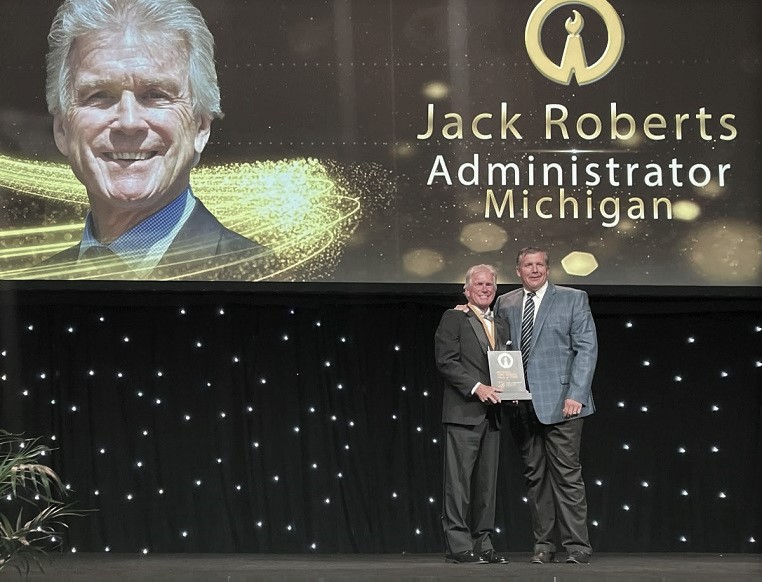With HOF Induction, Roberts Again Emphasizes Value & Values of School Sports
By
Geoff Kimmerly
MHSAA.com senior editor
July 14, 2022
Longtime and now-retired MHSAA executive director John E. "Jack" Roberts was inducted into the National Federation of State High School Associations (NFHS) Hall of Fame on July 1, 2022 – shining a light on high life's work of promoting, supporting and providing a valued national voice on education athletics during 32 years in that role from 1986 until his retirement in 2018.
Roberts was one of 12 honorees inducted during the NFHS summer meeting in San Antonio, Texas.
Roberts began his career serving as an assistant director for the National Federation from 1973-80. He was involved with the implementation of Title IX at the local and state levels and made immense contributions as the NFHS representative to the landmark Amateur Sports Act of 1978, and also played a significant role in the NFHS rules-writing process as the organization started writing and publishing rules for a number of new sports during the 1970s.
At the time of his retirement, Roberts was the nation’s longest-serving executive director of a state high school athletic association. He was the fourth person to serve the MHSAA in that leadership role full time, following Charles E. Forsythe (1931-42, 1945-68), Allen W. Bush (1968-78) and Vern L. Norris (1978-86).
Roberts also followed in the footsteps of his late father, John Roberts, who served as executive director of the Wisconsin Interscholastic Athletic Association from 1957-85 and was inducted into the National High School Hall of Fame in 2000. They are the first father-son team in the Hall of Fame.
The video above was shown as an introduction before Roberts was awarded his Hall of Fame plaque and medal during the induction ceremony. In the photo below, Roberts stands with current MHSAA executive director Mark Uyl.


Baseball's Record-Setting Spectatorship Headlines MHSAA's 2024-25 Attendance Report
By
Geoff Kimmerly
MHSAA.com senior editor
December 12, 2025
An overall attendance record in baseball and several more all-time bests for specific rounds of other sports’ postseason tournaments kept attendance at Michigan High School Athletic Association events near 1.4 million spectators for the third-straight school year in 2024-25.
Total, MHSAA Tournament events drew 1,397,574 spectators at competitions for which admission is charged – which counts all MHSAA-sponsored sports except golf, skiing and tennis, as single tickets are not sold for those postseason events. The total of just under 1.4 million spectators is a decrease of 3.6 percent from 2023-24, but still the third-highest overall attendance over the last eight school years.
Attendance at girls events for 2024-25 was 453,320 fans, a 3.9-percent decrease from the 2023-24 record-setting total but the second-highest over the last eight years.
The boys attendance of 944,254 was 3.4 percent fewer than the previous year. However, baseball set an overall tournament record with 65,150 spectators, with records as well of 38,086 at the District level and 7,517 attending Quarterfinals. Every round of the baseball postseason saw an increase from the previous year.
Overall attendance totals for the ice hockey, team wrestling, gymnastics, boys soccer and girls swimming & diving postseason tournaments also were up from 2023-24. Ice hockey set records at its Semifinals (7,758 spectators) and Finals (7,857), boys soccer at the District level (18,219) and team wrestling also at its Finals (11,604).
Football remains the most-attended MHSAA Tournament sport and drew 361,139 spectators for its playoff series – a decrease of just above a half-percent from the previous year but with the highest Finals turnout (44,535) since 2019-20. Boys basketball attendance remained second across all seasons at 251,668 spectators, followed by girls basketball at 145,313 and girls volleyball at 110,927.
Track & field (41,418 spectators) and softball (47,763) posted their second-highest attendances on record after setting records during the 2023-24 school year.
The MHSAA is a private, not-for-profit corporation of voluntary membership by more than 1,500 public and private senior high schools and junior high/middle schools which exists to develop common rules for athletic eligibility and competition. No government funds or tax dollars support the MHSAA, which was the first such association nationally to not accept membership dues or tournament entry fees from schools. Member schools which enforce these rules are permitted to participate in MHSAA tournaments, which attract more than 1.4 million spectators each year.

